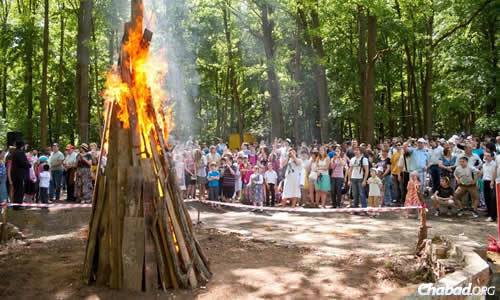|
Getting your Trinity Audio player ready...
|
By Rabbi Menachem Posner (Chabad.org)
Lag BaOmer 2024
Lag BaOmer, the 33rd day of the Omer count—this year, May 26, 2024—is a festive day on the Jewish calendar that honors Rabbi Shimon bar Yochai, author of the Zohar. It is celebrated with outings (on which children traditionally play with bows and arrows), bonfires, parades and other joyous events. Many visit the resting place (in Meron, northern Israel) of Rabbi Shimon, the anniversary of whose passing is on this day.
What It Means
Lag BaOmer is always on the 18th day of the month of Iyar. So what’s up with the name? The word “Lag” is made of of the Hebrew letters lamed (ל) and gimel (ג), which together have the numerical value of 33. “BaOmer” means “of the Omer.” The Omer is the counting period that begins on the second day of Passover and culminates with the holiday of Shavuot, following day 49.
Hence Lag BaOmer is the 33rd day of the Omer count, which coincides with 18 Iyar. What happened on 18 Iyar that’s worth celebrating?
When Is Lag BaOmer?
- Lag BaOmer begins at nightfall on Saturday night, May 25, 2024.
- Lag BaOmer ends at nightfall on Sunday, May 26, 2024.
What We Are Celebrating

Rabbi Shimon bar Yochai, who lived in the second century of the Common Era, was the first to publicly teach the mystical dimension of the Torah known as the Kabbalah, and is the author of the classic text of Kabbalah, the Zohar. On the day of his passing, Rabbi Shimon instructed his disciples to mark the date as “the day of my joy.”
The chassidic masters explain that the final day of a righteous person’s earthly life marks the point at which all their deeds, teachings and work achieve their culminating perfection and the zenith of their impact upon our lives. So each Lag BaOmer, we celebrate Rabbi Shimon’s life and the revelation of the esoteric soul of Torah.
Lag BaOmer also commemorates another joyous event. The Talmud relates that in the weeks between the Jewish holidays of Passover and Shavuot, a plague raged among the disciples of the great sage Rabbi Akiva (teacher of Rabbi Shimon bar Yochai), “because they did not act respectfully towards each other.” These weeks are therefore observed as a period of mourning, with various joyous activities proscribed by law and custom. On Lag BaOmer the deaths ceased. Thus, Lag BaOmer also carries the theme of loving and respecting one’s fellow (ahavat Yisrael).
How Is Lag BaOmer Celebrated
-
- Since this is the day of joy of Rabbi Shimon bar Yochai, there are major festivities in Meron, the mountain village in northern Israel where he is buried, with tens of thousands of pilgrims pouring in from all corners of the world to rejoice together in unity. Read more about Meron.
- All over the world, it is customary to spend the day outside, enjoying the natural beauty of G‑d’s world. During these outings, it is customary to play with bows and arrows.
- The mourning practices of the Omer period (see above) are lifted for this day. As a result:
- music is playing and people are singing and dancing with abandon.
- little boys who turned three during the Omer period but did not have their first haircut (upsheren) due to the mourning laws, have them today, often at Meron.
- weddings are held.
- Recognizing the fiery spirit of the mystical teachings that are celebrated today, bonfires are kindled. Get some friends (and a guitar) together, and it becomes a wonderful opportunity for singing, sharing and enjoying each other’s camaraderie.
- Customary foods for the day include carob (which miraculously sustained Rabbi Shimon and his son when they were hiding from the Romans) and eggs (a sign of mourning).
Lag BaOmer Parades
Beginning in the 1950s, the seventh Lubavitcher Rebbe, Rabbi Menachem Mendel Schneerson, encouraged Jewish children to join together in grand Lag BaOmer parades as a show of Jewish unity and pride. Held in front of the Lubavitch World Headquarters in Brooklyn, New York, the parades attracted—and still attract—thousands of children from all walks of life.
In 1980 the Rebbe gave instructions that Lag BaOmer parades and children’s rallies should take place not only in New York, but across the world, especially in Israel. Thousands of children participated in the tens of rallies that took place that year, and to this day, Chabad organizes hundreds of Lag BaOmer parades around the world every year.
Read more about the Lag BaOmer parades here.

Links for More on Lag BaOmer
The History of Lag BaOmer and Its Observance



